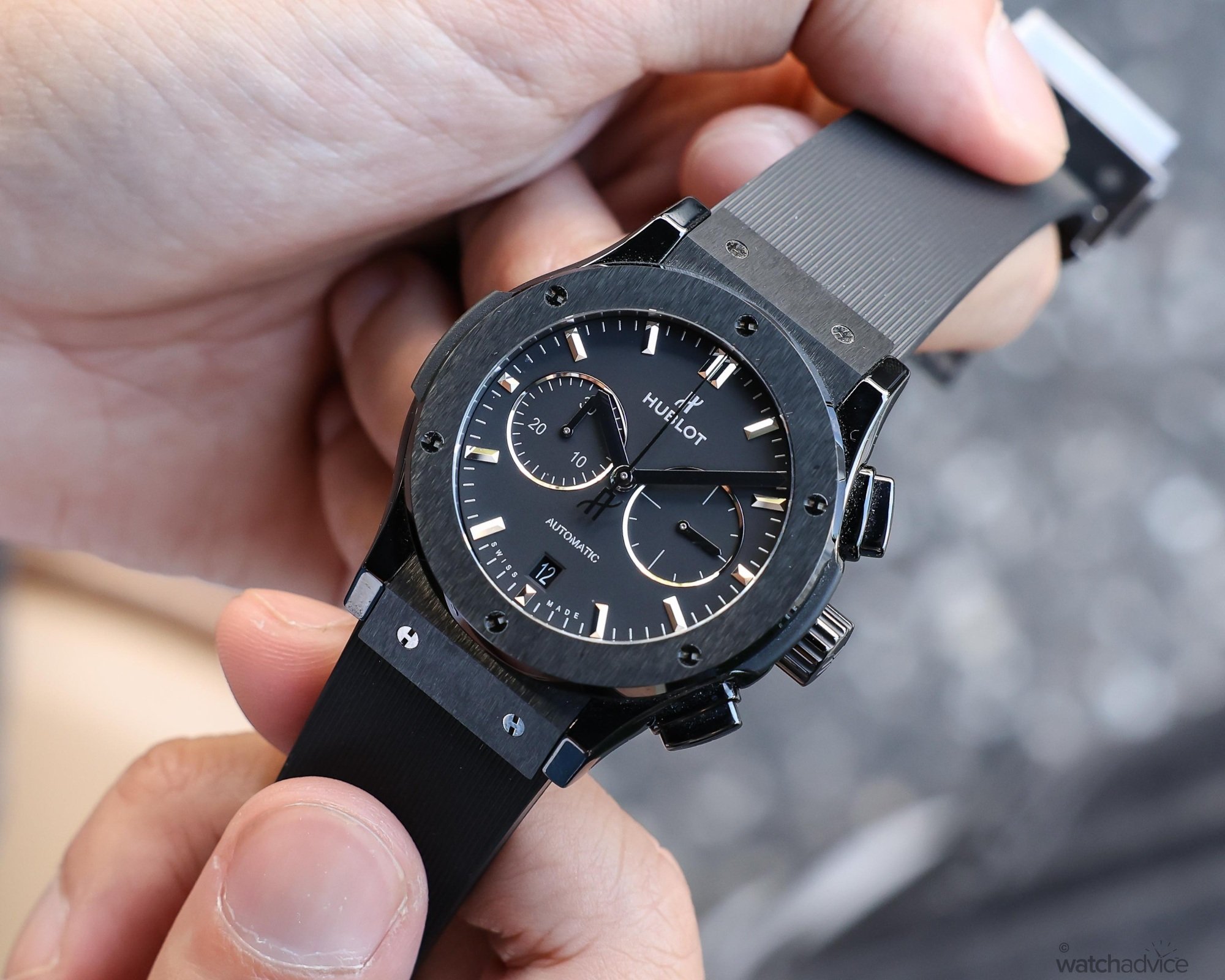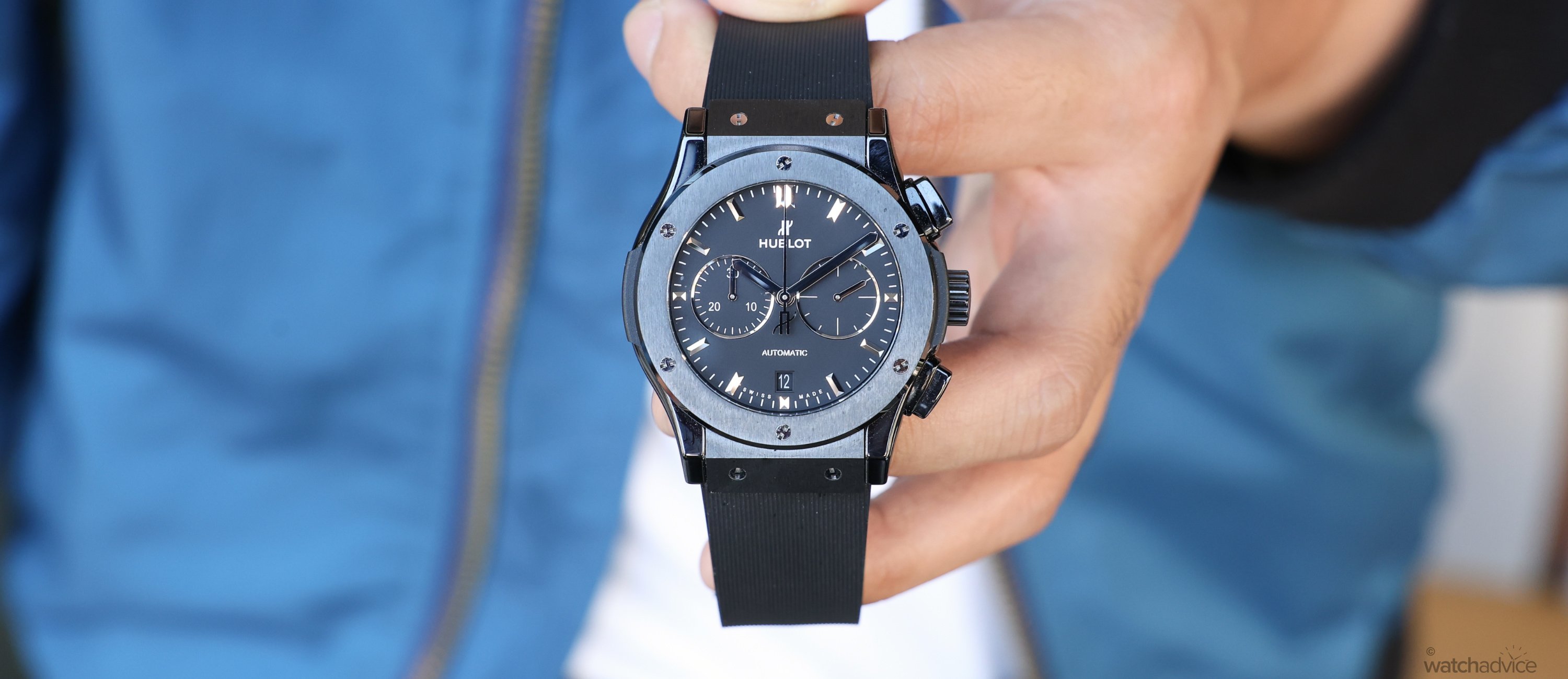Hublot are an ever-present disruptor of the traditional watch industry, but do the brand’s horological standards ‘walk the talk?’ Let’s find out!
What We Love:
- Tough, light & unobtrusive on-wrist
- Bold design married with demure aesthetics
- Surprising variation of finishes and detailing
What We Don’t:
- No lume on a sports watch?
- Chronograph operation feels tougher than most
- Movement choice makes for a challenging value proposition
Overall Rating: 8/10
- Value for Money: 7/10
- Wearability: 9/10
- Design: 8/10
- Build Quality: 8/10
When I was first introduced to the luxury watch industry and all the wonders it holds, it was an overwhelming experience. This isn’t a ground-breaking revelation – I’m sure many of you shared the same circumstances at one point – but I found myself quickly scrambling for some watch advice, no pun intended. However, since I was the only watch nerd (that I knew of) in my demographic, I naturally navigated online.
There, I was told a great many facts and rules. Some of them were good, like “don’t change the date between 9 and 3 o’clock,” or “take the watch off before you adjust the time.” Other bits and pieces, however, were just opinions disguised as fact. “Never buy [this brand],” “only buy [that brand] …” All the typical drivel we roll our eyes at now; I integrated into my own beliefs as a then watch noob.
Of course, this also led me to one of the watch community’s biggest discourses: Hublot. From what I saw, the discussion always led one of two ways: Why Hublot was the horological equivalent of the Devil, or confusion as to why those enforcing the former thought that way. It’s like Hublot as a topic was always surrounded in some Warhammer-esque conflict – an endless series of ‘hot takes’ that ultimately led nowhere.
So, when I joined up with Watch Advice, I saw an opportunity to drown out the noise; A moment to remove myself from the online flame wars and finally formulate my own take on this incredibly polarising brand. This year, that opportunity finally came, when the Watch Advice team opened the floor to me to finally review a Hublot.
First Impressions
Okay, now I’ve decided to dive into the figurative belly of the beast. So where should I start? While I had become very familiar with Hublot as a brand – what with the Watch Advice team having interacted with them on innumerable occasions, of which I’ll list as we go – I was eager to develop my own lived experience with the Swiss watchmaker.
I could’ve swung for the fences – requesting a King Gold, or a Square Bang, or one of their even crazier pieces; A veritable ‘best hits of Hublot’ roster constantly whirled around in my head. Instead, I decided to see Hublot in their standard form, ending up with the Classic Fusion Black Magic Chronograph.
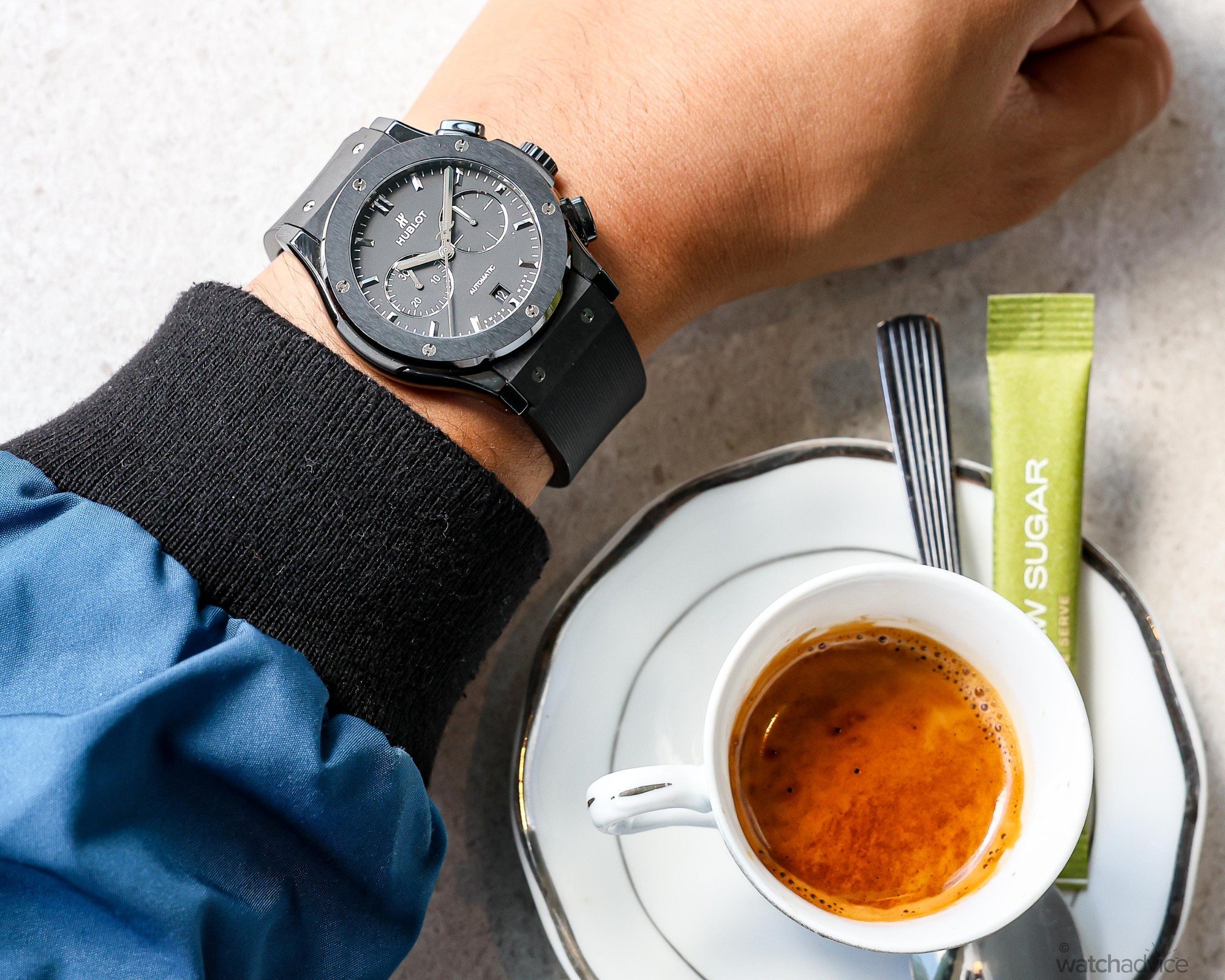
Not like there is a ‘standard form’ for Hublot, given their propensity to experiment like nobody’s business, but the Classic Fusion is probably best to test their horological efficacy. Based on the original Carlo Crocco design from the 1980s, the Classic Fusion is the modern shakeup and the founding staple of the brand formerly known as MDM Geneve. Combining timeless simplicity with the then-daring feature of a rubber strap, the Classic Fusion line was positioned as evolutionary evidence of the brand’s ethos.
One of my favourite subgenres within the collection is the Black Magic series. Pervading several different collections, they denoted timepieces made mostly or entirely out of black ceramic. So, as opportunity knocked, I answered – keenly looking forward to trying out a Hublot myself. However, given how deeply ingrained the online vitriol had become, I did my absolute best to maintain an open mind during the review, freeing myself of any preconceived notions as I donned it on my wrist.
The Design
Hublot’s Classic Fusion silhouette is one of the easiest to recognise in the industry. Yet for an all-black watch, it may surprise those unfamiliar with the brand just how much detail Hublot builds into the design.
Setting the tone is the dial, which as the Black Magic name suggests is matte black — about as simple as Hublot gets. Like most black dials, though, it works as a clean canvas for the other elements. These include a white printed minute track that contrasts against the dial, which encircles the indexes, subdials, 6 o’clock date window, and the hands.
The first thing you might notice, though, is the complete absence of lume. For a collection often considered an icon among sports watches, it may feel unusual. But looking back at original MDM Genève references, which also lacked lume, it makes sense in the context. Enlarged hands and indexes to accommodate it may have thrown off the watch’s proportions, and in some ways, it’s better to have none at all than a weak, token glow. Still, at times the watch does feel as if it’s missing something important.
It seems that Hublot are keenly aware of this, though, as they make up for it with brilliant finishing. The baton indexes and hands are highly polished and bevelled, catching the light in any environment. The second hand, while not bevelled, also shines with a polished finish, its counterbalance shaped as Hublot’s ‘H’ logo.
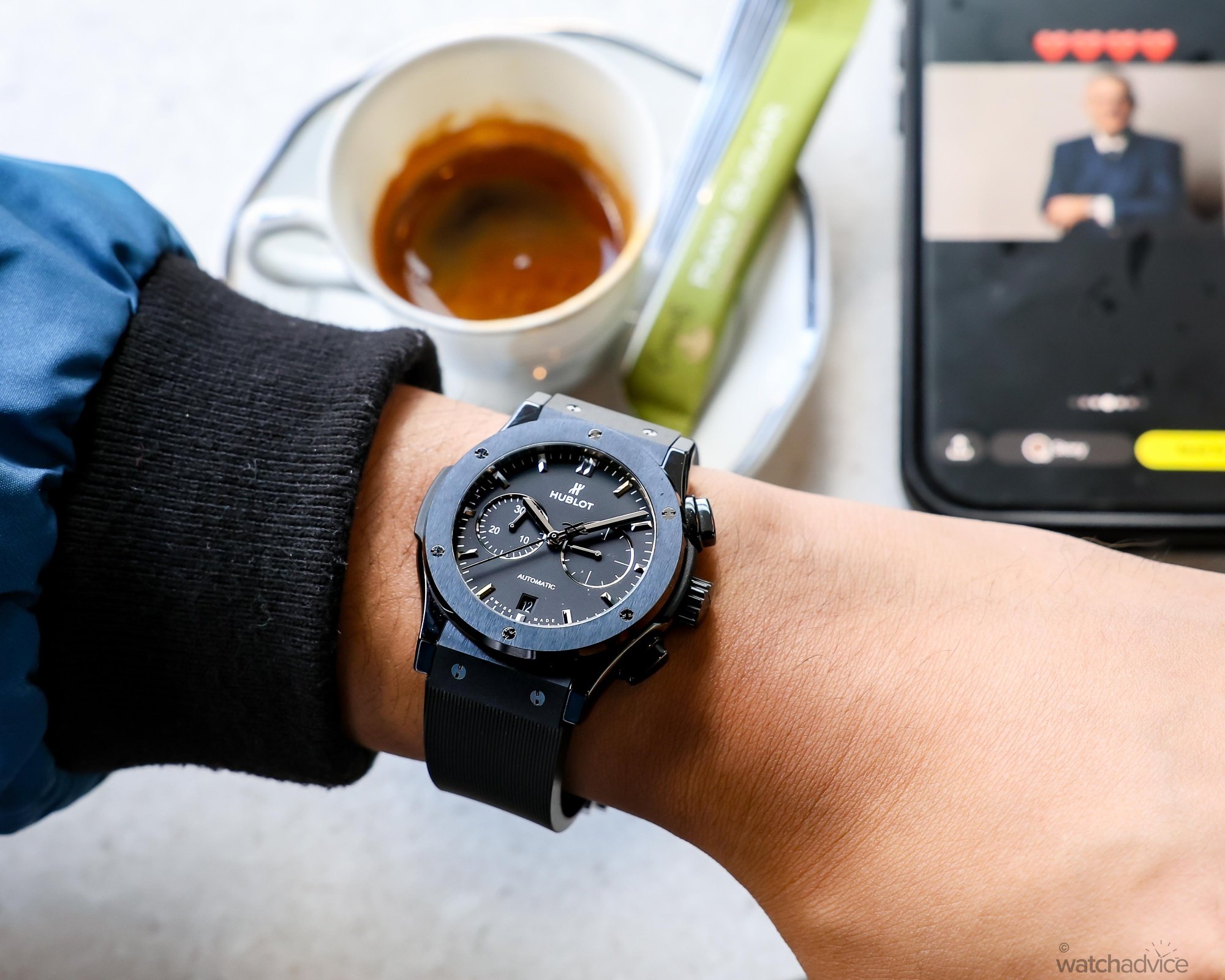
The chronograph subdials follow suit, with polished hands and borders set against white printed tracks. It’s a thoughtful balance, and one I wish extended to the 6 o’clock date window. Despite its white Arabic numerals, the window tends to disappear at a glance. It is colour-matched, though, so that compromise helps maintain the dial’s clean aesthetic. The 9 o’clock subdial counts chronograph minutes on a 30-minute register, while the 3 o’clock subdial serves as the small seconds, and flanking the date window are the words ‘SWISS’ and ‘MADE.’ Meanwhile, the rehaut — the inner edge of the dial — is finished with a horizontal brushing.
Moving out from the dial, the brushed finish continues with the vertically brushed ceramic bezel, framed by polished bevels and Hublot’s signature six titanium H-shaped screws. Evocative of the French word hublot — meaning porthole or window — these screws have been a hallmark of nearly every Hublot watch since the brand’s inception.
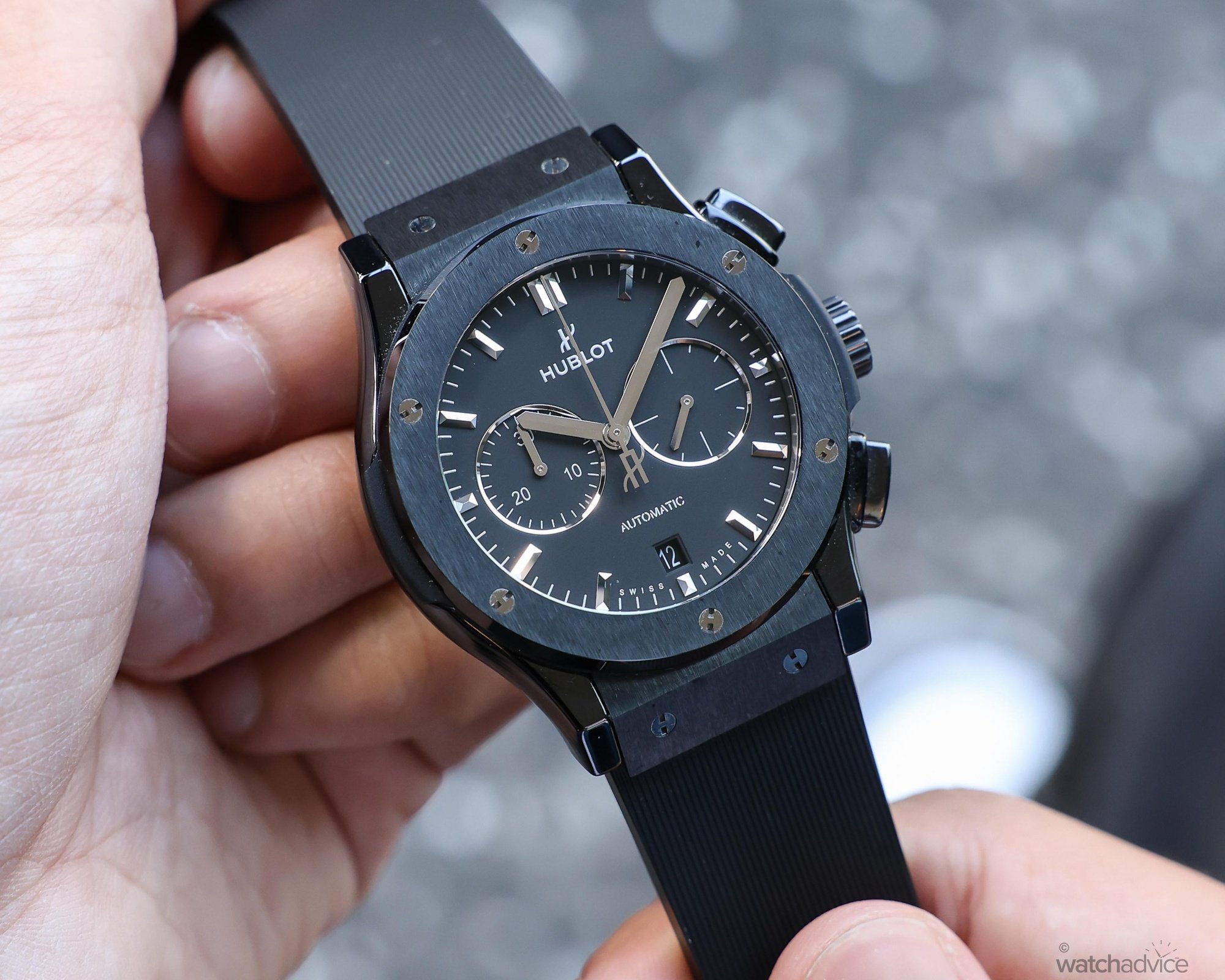
This brings me to another frequent point of contention, at least online: screw alignment. A vocal minority often criticises Hublot here, pointing to the Audemars Piguet Royal Oak as the supposed ‘standard.’ Some of us use this example to accuse Hublot of cutting corners, but that couldn’t be further from the truth. The difference, in reality, lies in construction. The Royal Oak’s screws are actually a three-part system: the hexagonal heads visible on the bezel are bolts designed for presentation, secured from behind by a nut and hollow screw, which hold the entire multi-part case together, front to back.
As a result, the visible bolts can be neatly aligned while the hidden fasteners remain unaligned. Hublot’s screws, by contrast, are standalone and designed to fix the bezel to the case only, secured directly from the top without a nut-and-bolt arrangement. Because of this, perfect alignment simply isn’t possible — Yet Hublot still cops criticism for it. If misaligned screws were such a deal-breaker, though, watches like the Cartier Santos — another icon littered with exposed, unaligned screws — would never have succeeded.
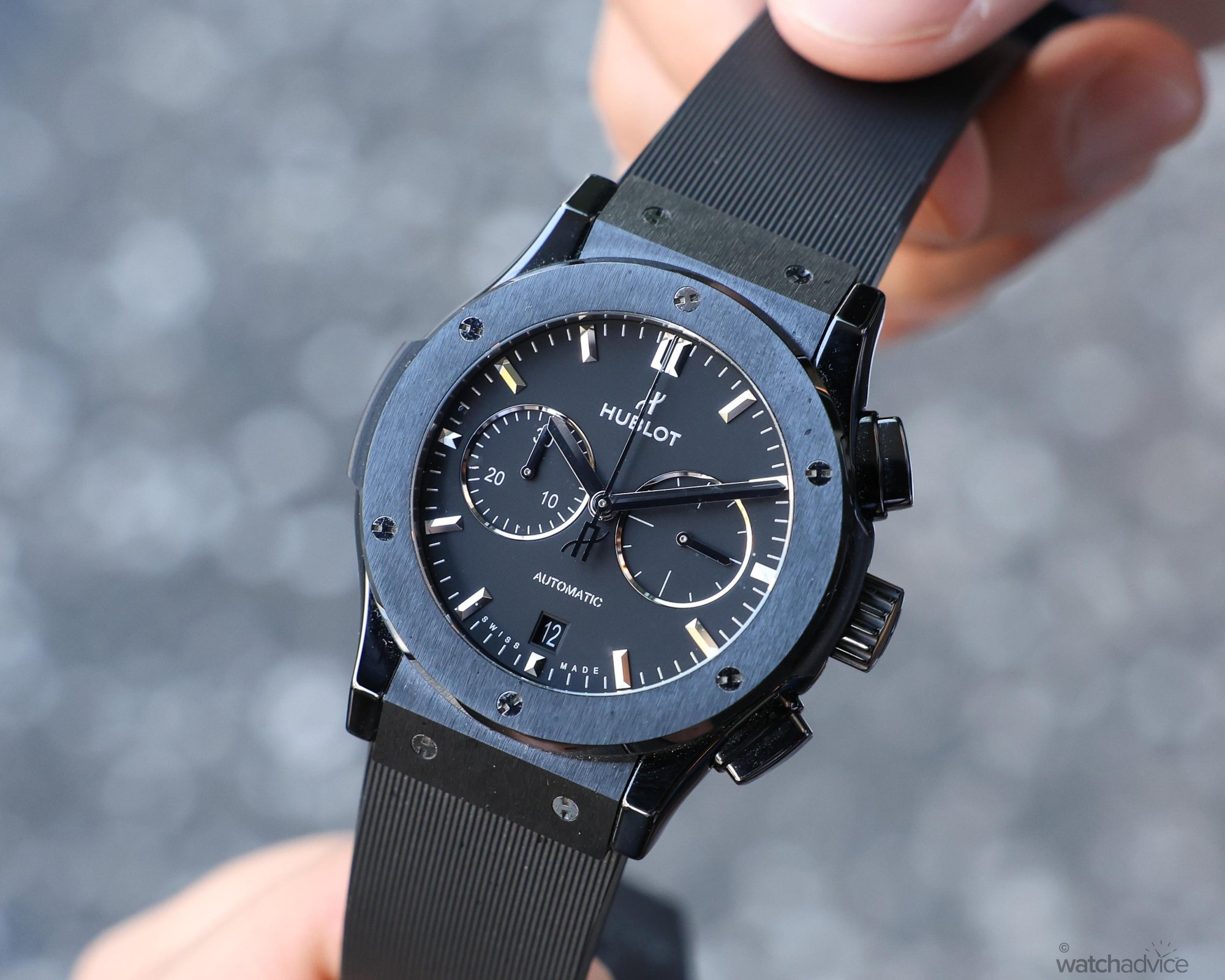
The brushed finishing of the Black Magic Chronograph continues onto the lugs, secured with two more H-screws on each side. Moving outward, polished ceramic components provide subtle contrast against the matte black rubber inset within the mid-case. Staying true to Hublot’s philosophy of the Art of Fusion, the Classic Fusion Black Magic Chronograph blends ceramic, titanium, and rubber into a cohesive design that preserves the brand’s sporty character.
I’ll admit I have personal reservations about rubber in watch cases, but here it’s used sparingly enough to add texture without feeling intrusive. The Hublot ‘H’ appears again on the fluted push-pull crown, which offers 50 metres of water resistance, and is polished to match the adjacent chronograph pushers.
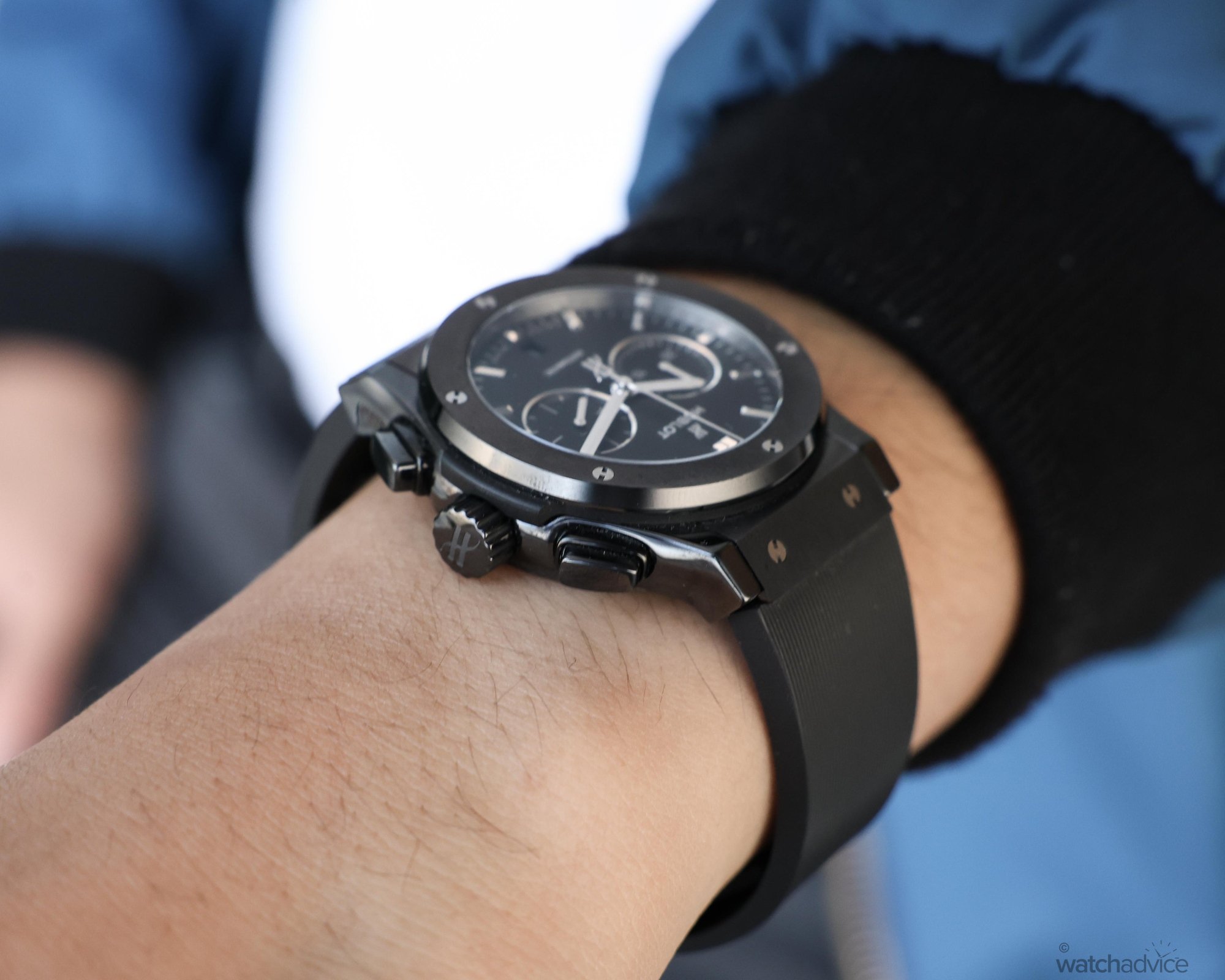
The design flows into the black rubber strap — another Hublot signature, with the brand being the first to integrate rubber into a luxury sports watch. The strap closes with a folding clasp and deployant buckle crafted from both black DLC titanium and ceramic. A neat detail here is yet another nod to the Hublot ‘H,’ subtly integrated into the buckle itself. Finally, the watch is completed by a sapphire caseback. Its periphery carries the familiar engraved text while the centre reveals the movement within.
Whatever one’s feelings about Hublot, a closer look at this watch shows just how much thought and care goes into its construction. Sure, the Classic Fusion Black Magic Chronograph may not be as outrageous as some of its stablemates, but it’s a strong example of how Hublot can distil its design ethos into something more restrained.
How It Wears
A more svelte watch by Hublot’s standards, the Classic Fusion Black Magic Chronograph is perhaps the most familiar-wearing piece in a catalogue otherwise defined by bold ambition. Measuring 42mm across, with a 48mm lug-to-lug and 12.2mm thickness, it sits well on the wrist. On my 6.4-inch (16.3cm) wrist, it wore true to size — if not slightly smaller — compared to other watches with similar dimensions. A clear contrast is the TAG Heuer Carrera 42mm, which shares similar measurements but, with its 2mm thicker case, wears noticeably larger.
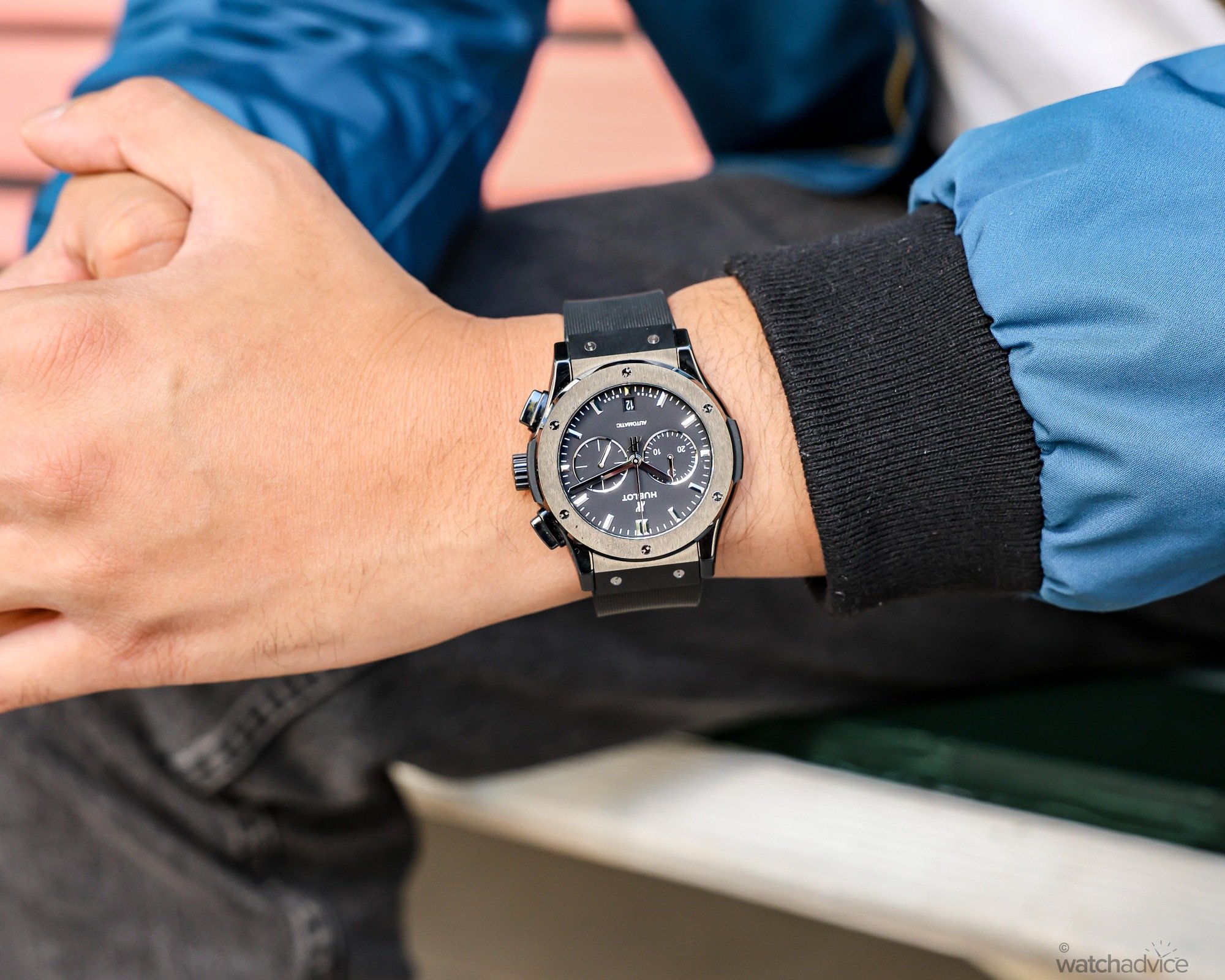
The wearability mostly comes down to construction. The case combines three materials — black ceramic, black DLC titanium, and rubber — that are both highly durable and impressively light. The all-black colourway also plays a role: because black absorbs rather than reflects light, it softens details and creates the illusion of a smaller case. The lugs, sharp from above but elegantly curved, flow down to the wrist, aided by the watch’s curved side profile. Together, these features, combined with the lightweight materials, make for a surprisingly modest and comfortable wearing experience.
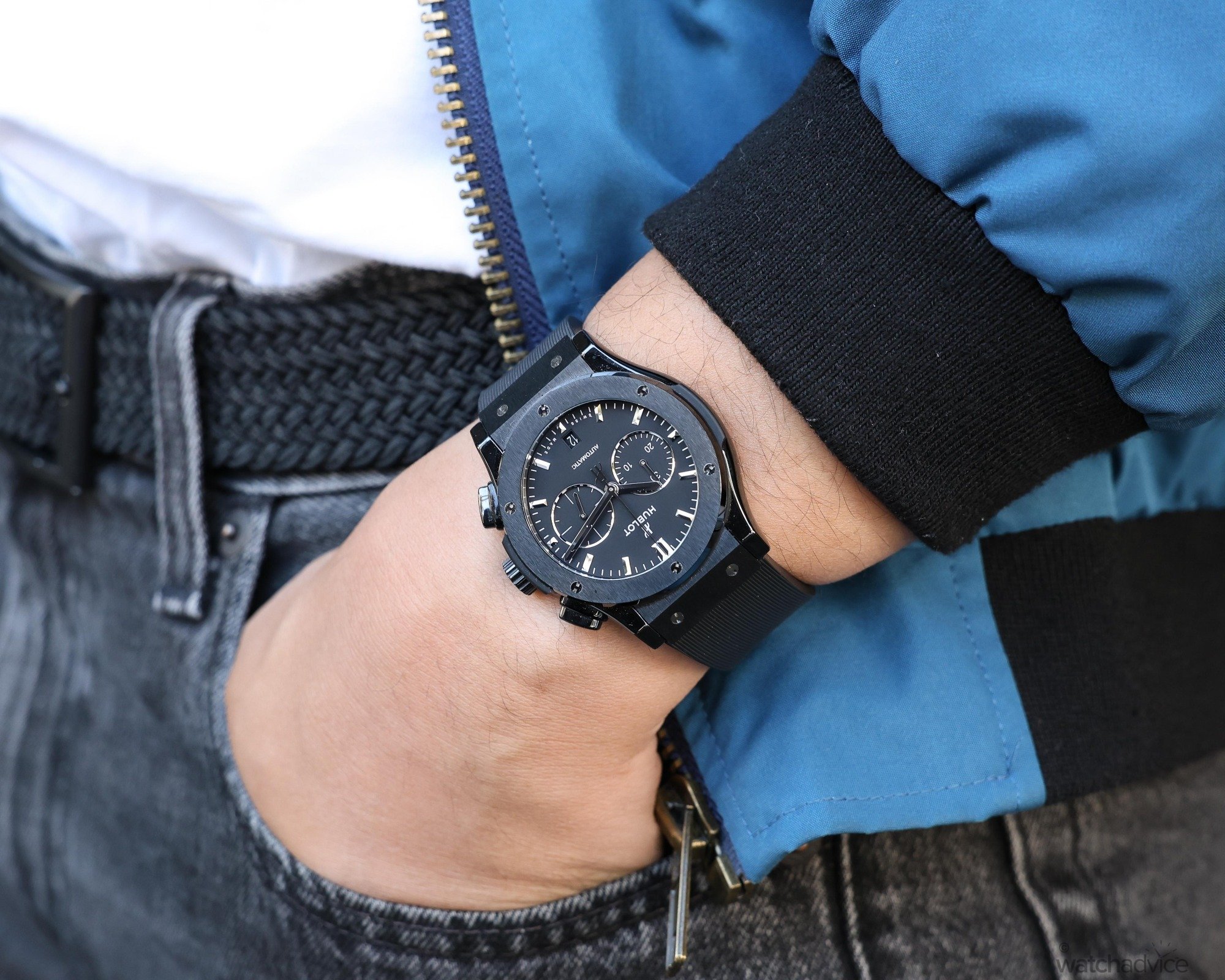
My only reservation, then, lies with the water resistance. At 50 metres, it feels a little conservative for a sporty chronograph on a rubber strap. That said, it’s not unusual for the category — the Omega Speedmaster, for instance, carries the same rating. Still, with 100 metres becoming more common, Hublot could benefit from adopting that standard.
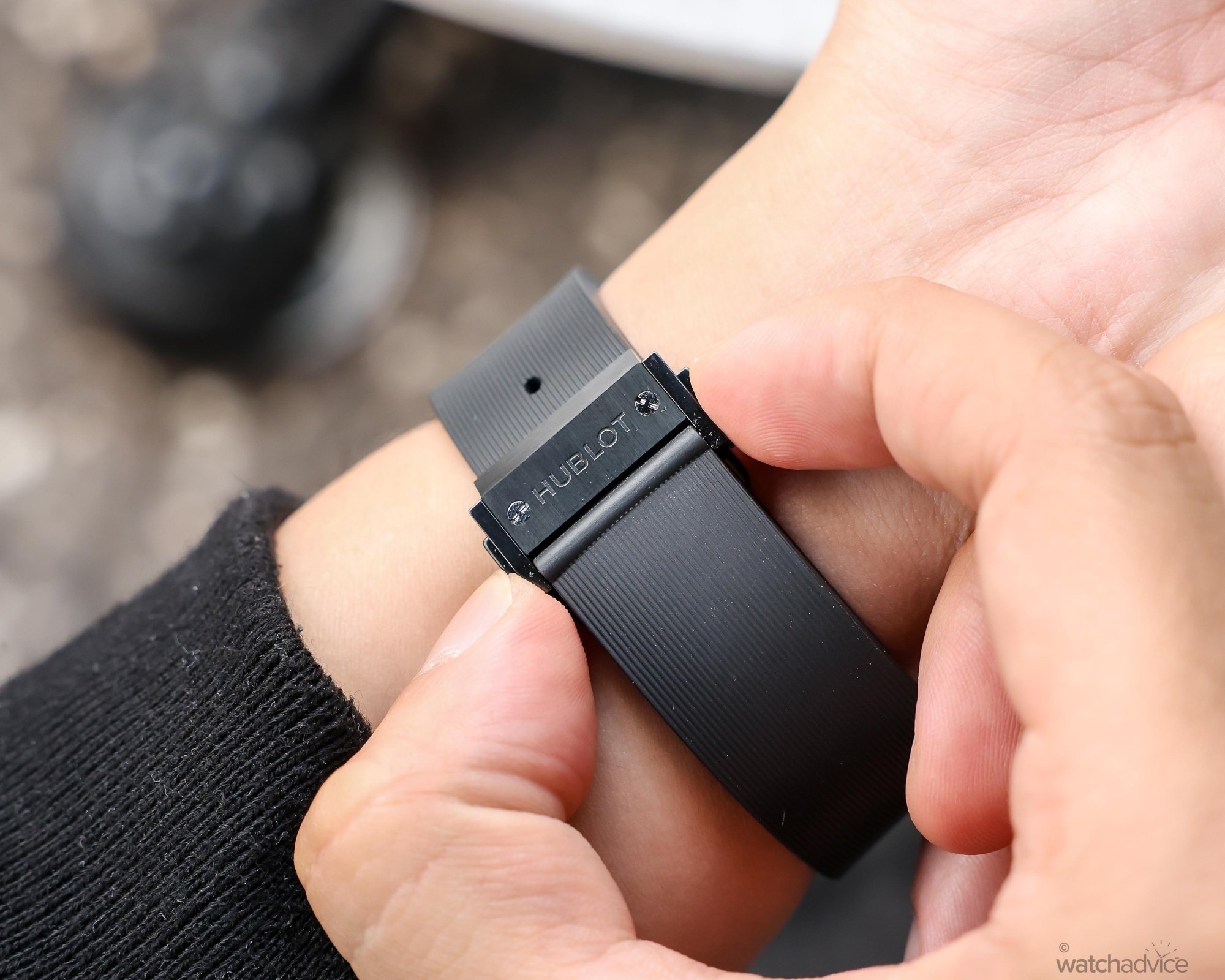
The rubber strap itself, however, might be one of the best I’ve worn. Given Hublot pioneered the use of rubber in luxury watches, expectations are high, and this strap delivers. It’s extremely comfortable, and while I don’t usually prefer deployant buckles, Hublot’s design felt intuitive and easy to operate. The material also inspires more confidence than leather; I never worried about deforming it when adjusting the tightness of the clasp, which no doubt added to my overall enjoyment.
The Movement
For the Classic Fusion Black Magic Chronograph, Hublot’s movement of choice is the tried-and-tested HUB1153. Like other watches in the Classic Fusion line, this is not an in-house calibre. Its reliability stems from its base architecture, the ETA 2892-A2, which runs at the industry-standard 4Hz (28,800VpH) with a practical 42-hour power reserve, alongside a chronograph complication.
This is where opinions often diverge when it comes to Hublot. At a price of AU$19,300 at the time of writing, some enthusiasts struggle with the brand’s reliance on the ETA 2892-A2. I won’t echo the community’s harsher criticisms — especially given how toxic those debates can become — but the concerns are understandable. In my experience, the chronograph operation feels a little stickier than I’m used to, and while the finishing is neat, it’s otherwise unremarkable save for the blackened ‘HUBLOT’ text on the custom rotor.
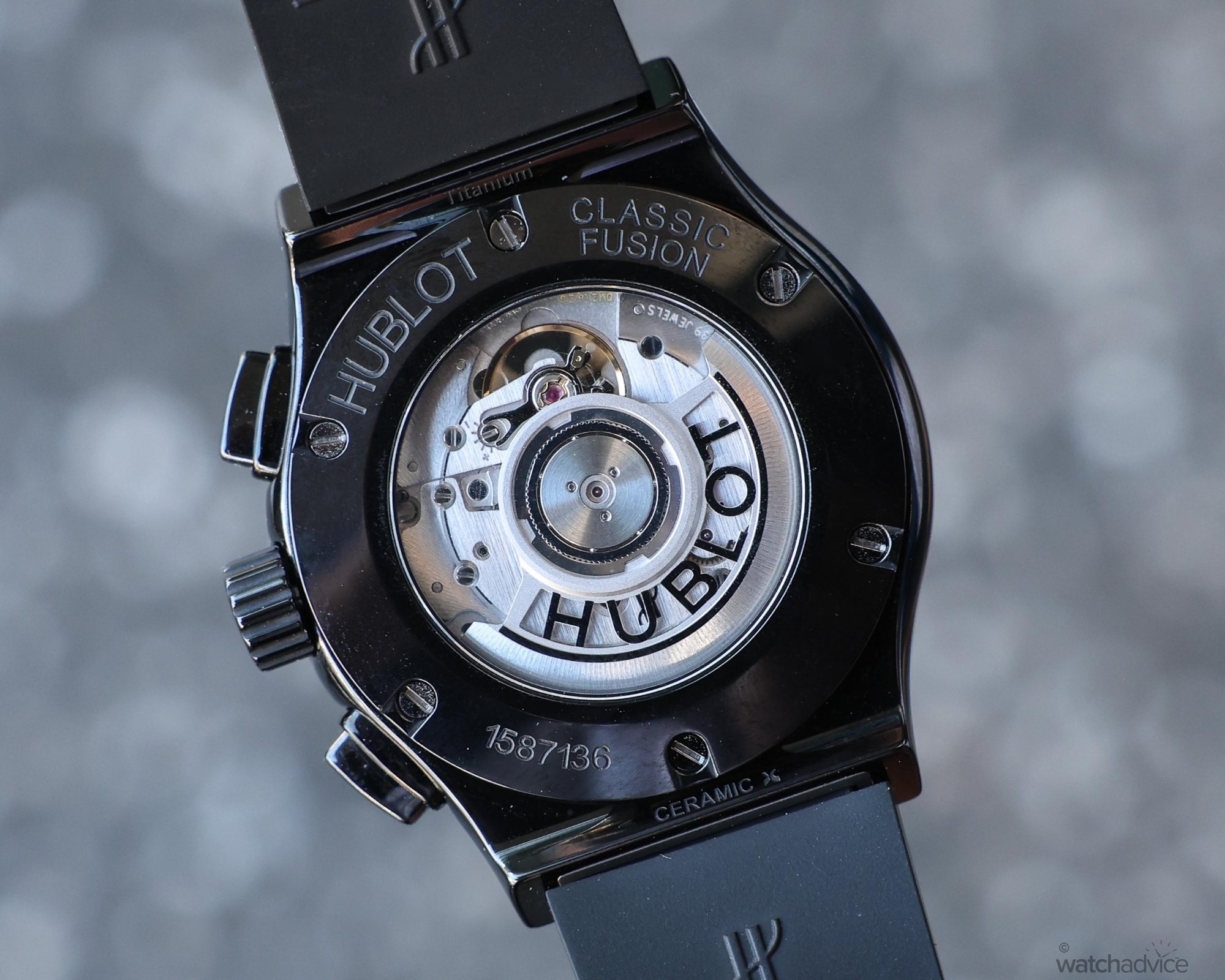
But should you be horrified or put off? Not really, and there are a few reasons why. First, just because the ETA 2892-A2 is an industrially standardised movement doesn’t make it bad — in fact, quite the opposite. Hundreds of brands have relied on it across thousands of watches, including Longines, Oris, TAG Heuer, Tudor, and countless others. Its widespread use also means the Classic Fusion Black Magic Chronograph is easier to service, as most watchmakers will be thoroughly familiar with its inner workings.
This leads into my next point, which Matt also raised in his review of the Hublot Aerofusion Titanium Chronograph:
The fact that many mainstream brands still use movement bases from ETA or Sellita is still common as it does take substantial capital (and space) to build out a Manufacture with full in-house capabilities – one reason brands that are owned by the likes of LVMH or Richemont do have centralised movement facilities for some of their more entry level brands and models.
The Hublot Aerofusion Titanium Chronograph Is Fun On the Wrist!
Thanks, Matt! Point being, Hublot is only 45 years old, having been founded in 1980. In watchmaking terms, that means it’s still relatively young at under half a century old. While Hublot has invested heavily in its higher-end watches and in-house movements — just look at some of the fascinating pieces produced at their manufacture — it will still take more space, more money, and more time before their entire line-up can be powered by fully in-house calibres.
That might test the patience of some enthusiasts, but perspective helps: Omega, for example, took about four decades to move towards in-house movements, having relied on ETA throughout the 80s and 90s. As Hublot and its manufacture continue to grow, it’s reasonable to expect those capabilities to eventually filter down into the Classic Fusion line. As it stands, it’s still certainly a tough value proposition for the seasoned enthusiast, but given the ambition already shown in their haute horlogerie creations, I’ve no doubt Hublot are looking to shift gears sooner rather than later.
Final Thoughts
If there’s one thing you should know about this polarising brand, it’s this: Hublot makes serious watches for people who are not. This approach has certainly ruffled some feathers in the watch world, especially for those who often glaze traditional craftsmanship. But it also speaks volumes about Hublot’s place in the watch world — a devil’s advocate made manifest, forcing staunch purists to question the true boundaries of watchmaking.
Hublot isn’t trying to be another heritage-driven manufacture obsessed with legacy; it doesn’t need to, given its relative youth within the horological space. Instead, it leans into contemporary design, experimental materials, and a philosophy that embraces fun as much as mechanical excellence. By doing so, it challenges the idea of what a luxury watch could and should be, opening the door to an audience that might feel alienated by conservative brands. That doesn’t mean Hublot sacrifices quality — far from it — but its focus is on creating watches that are bold, wearable, and undeniably different.
Despite my own misgivings — which admittedly come from something of an ivory tower — we’re often taught that a brand must tick countless boxes to be deemed worthy. Yet no matter how many it does, the internet watch community will always demand more. Hublot has made a point of sidestepping those expectations, creating timepieces that are not only well-crafted but also practical, versatile, and entertaining. Put into that context, I don’t see why there should be an issue.
At AU$19,300, though, the competition is brutal, particularly in the ceramic chronograph space. Pieces like the AU$19,000 IWC Lake Tahoe or AU$22,675 Omega Speedmaster Dark Side of the Moon present strong alternatives, especially when you factor in their ceramic construction and in-house movements. However, both lean towards a more professional crowd — and perhaps risk feeling too restrained for someone just discovering Hublot. While the Classic Fusion Black Magic Chronograph is itself restrained, it never feels uptight on the wrist. Instead, it delivers a carefree, versatile wearing experience amplified by Hublot’s ongoing commitment to the Art of Fusion.

Overall, this watch is a likeable piece that rarely left my wrist. For what is considered a ‘standard’ Hublot, it remains surprisingly distinct compared to its contemporaries. My only hope is that potential owners are ready for it to get a lot more wear than they might initially expect. Love them or hate them, Hublot’s approach to watchmaking keeps the conversation alive — and in an industry that risks stagnation under the weight of tradition, that might be the most serious contribution of all. The fun, bold, and highly wearable design of this timepiece are not it’s consolation prizes; Rather, they are the foundation of Hublot’s brand identity. With that said, the Classic Fusion Black Magic Chronograph is worth considering as your collection’s dark horse.
Reference: 541.CM.1171.RX
Specifications
- Dimensions: 42mm case diameter x 48mm lug-to-lug x 12.2mm thickness
- Case Material: Brushed/polished black ceramic/titanium with black rubber insets
- Dial: Matte black with polished baton hands & indexes
- Movement: Automatic Cal. HUB1153 (Base ETA 2892-A2) with chronograph (30min register), date, & small seconds complications
- Power Reserve: 42h
- Beat Rate: 4Hz (28,800VpH)
- Water Resistance: 50m (5bar)
- Strap: Black rubber strap with black ceramic & DLC titanium pin-and-buckle folding clasp
Australian RRP: AU$19,300
Availability: Available now, online at Hublot.com or at all Hublot boutiques and authorised retailers.
Image Gallery

